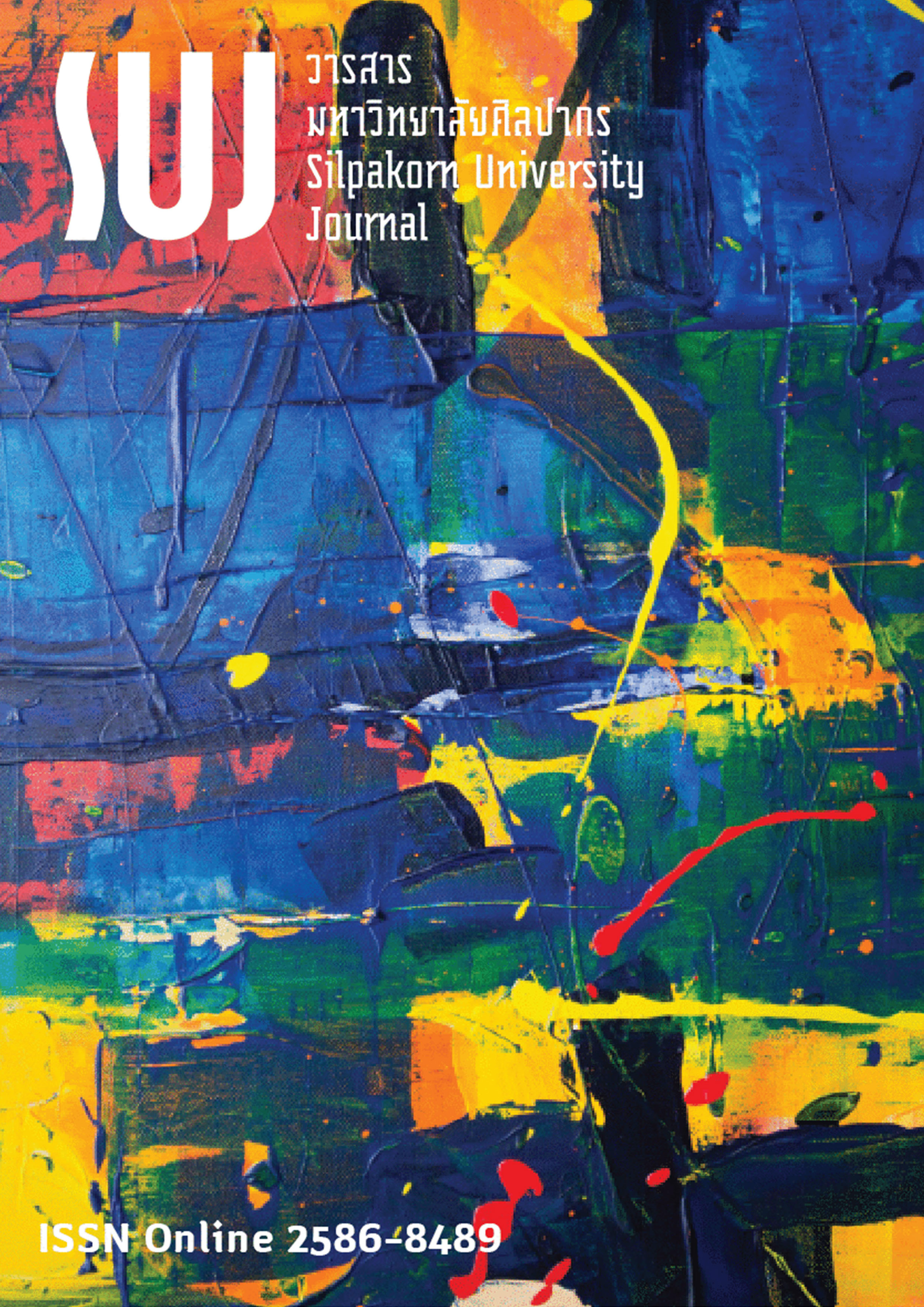สัญลักษณ์และประวัติคีตวรรณกรรมสยามโดย “พระอภัยพลรบ”: นักวิทยาดนตรี คนแรกของประเทศไทย (The Siamese historical music transcription of “Phra Aphaipholrop”: The pioneer musicologist of Thailand)
Main Article Content
Abstract
ผู้วิจัยได้ศึกษาวิเคราะห์เอกสารตำราเรียนด้านดนตรีวิทยาของนายพันโท พระอภัยพลรบ จำนวน 3 เล่ม เป็นหลัก ได้แก่ 1. ดนตรีวิทยา (พ.ศ. 2455) 2. แบบหัดอ่านเสียง เล่ม 1 (พ.ศ. 2455) และ 3. ตำราเขียนและอ่านเพลงอาณัติสัญญาในกรมทหารบก (พ.ศ. 2451) เพื่อวิเคราะห์เครื่องหมาย (signs) ต่าง ๆ ที่มีผลต่อการให้ความหมายของ “ดนตรี” ภายใต้บริบททางประวัติศาสตร์ที่เกี่ยวข้องระหว่างช่วงปี พ.ศ. 2450 - 2475 พบว่า “ดนตรีวิทยา” และ “แบบหัดอ่านเสียง เล่ม 1” เป็นแบบเรียนดนตรีคู่แรกของไทยที่ถูกกำหนดขึ้นในปี พ.ศ. 2455 ในขณะที่ “ตำราเขียนและอ่านเพลงอาณัติสัญญาในกรมทหารบก” ได้ใช้ในการเรียนการสอนของโรงเรียนนายร้อยทหารบก โดยทำนองสัญญาณแตรต่าง ๆ ที่ใช้บรรเลงในปัจจุบัน เป็นผลจากการปรับปรุงโดยพระอภัยพลรบ ทั้งนี้ ตำราทางดนตรีวิทยาของพระอภัยพลรบประกอบด้วยเครื่องหมายต่าง ๆ ที่เข้าใจได้ยากเป็นจำนวนมาก รวมถึงยังไม่เคยได้รับการศึกษาจากนักวิชาการทางดนตรีมาก่อนนับตั้งแต่ถูกเขียนขึ้น การศึกษาครั้งนี้จึงให้ข้อเสนอที่สำคัญ ได้แก่ 1. ข้อเสนอเรื่องตำแหน่งของเสียง “โด” แบบเคลื่อนที่ หรือระบบเสียงสัมพัทธ์ (relative pitch) บนบันไดเสียงซี ซึ่งแตกต่างจากข้อเสนอเรื่องตำแหน่งเสียงโดในดนตรีไทยของพระเจนดุริยางค์ที่เสนอให้ใช้ระบบระดับเสียงสมบูรณ์ (absolute pitch) และเทียบใหม่บนเสียงบีแฟลต และ 2. ข้อเสนอเรื่องวิธีการบันทึกอัตราจังหวะที่หลากหลายของเพลงไทยอย่างน้อย 7 รูปแบบนั้น มีความแตกต่างจากวิธีที่นิยมใช้ในปัจจุบัน
This research studied and analyzed the script which mainly derived from the three historical textbooks written by Phra Aphaipholrop. They include 1. Dontriwittaya [Musicology] (1912) 2. Bab Hud Arn Saeng Lem 1 [Music Reading Practice, Book 1] (1912), and 3. Tamra Kaen Lae Arn Pleng Arnutsunya Nai Krom Taharn Bok [How to Write and Read the Bugle Call for Army Regiment] (1908). The study was to analyze meanings of signs that enhanced the definition of "music" in the relevant historical context from 1907 to 1932. This study found that Dontriwittaya and Bab Hud Arn Saeng Lem 1 were the first music textbooks in Thailand, while Tamra Kaen Lae Arn Pleng Arnutsunya Nai Krom Taharn Bok was developed to be a textbook studied at the Army Cadet Academy. This bugle call’s signals were mandated and revised by Phra Aphaipholrop. His textbook contained a large number of incomprehensible marks, which had never been studied by a music scholar since it was written. In particular, the research has two important proposals. First, the positional concept of a “moving C" in music as a relative pitch system was different from Phra Chenduriyang’s proposition, which suggested to use the absolute pitch system for Thai music as Thai-C and subsequently by B-flat in pitch. Second, variety of rhythmic rates of music could be presented in at least 7 types in Thai music notation, which differs from the common practice at present time.
Downloads
Article Details

This work is licensed under a Creative Commons Attribution-NonCommercial-NoDerivatives 4.0 International License.
References
Arunrat, Pongsilp. (1994). Biography and Works of Kru Phraya Prasanduriyasap (Plaek Prasansap) (ชีวิตและงานของครูพระยาประสานดุริยศัพท์ (แปลก ประสานศัพท์)). Master’s dissertation, Mahidol University, Nakorn Pathom, Thailand.
Chaophraya Mahindrasakthamrong. (1988). The Royal Writing of King Mongkut, Volume V and Chao Phraya Mahindrasakthamrong’s Stories (พระราชหัตถเลขาในพระบาทสมเด็จพระจอมเกล้าเจ้าอยู่หัว ภาคที่ 5 และชานพระศรีของเจ้าพระยามหินทรศักดิ์ธำรง). Bangkok: Literature and History Division, Fine Arts Department.
Cox, G., & Stevens, R. (Eds.). (2010). The Origins and Foundations of Music Education. London: Continuum.
Curwen, J. (1892). Tonic Sol-fa. London: Novello, Ewer, and Co.
Department of War and Marine. (1905). Regulations on the Use of Signs Mandates in the Army Regiment (ข้อบังคับว่าด้วยการใช้อาณัติสัญญาต่าง ๆ ในกรมทหารบก). Phranakorn: Sophonphiphanthanakorn Printing.
Kassuwan, Boonlert. (1977). Bugle’s Signal Call (สัญญาณแตรเดี่ยว). n.p.
King Chulalongkorn. (1970). Archives of the King Chulalongkorn, Returning from Europe after R.S. 126 (จดหมายเหตุการรับเสด็จพระบาทสมเด็จพระจุลจอมเกล้าเจ้าอยู่หัว เสด็จกลับจากยุโรปครั้งหลัง ร.ศ. 126, พิมพ์เป็นอนุสรณ์ในงานพระราชทานเพลิงศพ หม่อมจันทร์ เทวกุล ณ เมรุวัดธาตุทองพระขโนง). Phranakorn: Phrachan Printing.
Kromphra Sommod-amornphan. (1970). The Stories of Chao Phraya in Rattanakosin Period (เรื่องตั้งเจ้าพระยากรุงรัตนโกสินทร์). Bangkok: Prime Minister’s Office.
Nawikkamun, Anek. (2006). The Siamese Nobleman 1 (ขุนนางชาวสยาม 1). Bangkok: Saengdao.
Phra Aphaipholrop. (1908). How to Write and Read the Bugle Call for Army Regiment (ตำราเขียนและอ่านเพลงอาณัติสัญญาในกรมทหารบก). n.p.
Phra Aphaipholrop. (1912a). Musicology (ดนตรีวิทยา). Phranakorn: Sophonphiphanthanakorn Printing.
Phra Aphaipholrop. (1912b). Music Reading Practice, Book 1 (แบบหัดอ่านเสียง เล่ม 1). Phranakorn: Sophonphiphanthanakorn Printing.
Phra Chenduriyang. (1973). Thai Music. Bangkok: The Fine Arts Department.
Stevens, R. S., & Akrofi, E. A. (2004). Tonic Sol-fa in South Africa — A Case Study of Endogenous Musical Practice. In Australian Association for Research in Music Education: Proceedings of the XXVIth Annual Conference, (pp. 301-314). Melbourne: Australian Association for Research in Music Education.
Stumpf, C. (1901). Tonsystem und Musik der Siamesen. Beiträge zur Akustik und Musikwissenschaft, 3: 69-138.
Thomas, W. (1945). Cerddoriaeth yng Nghymru: Llyfryddiaeth (Music in Wales). Welsh: Gwasg Carreg Gwalch.
Tramot, Boontham. (1938). Lectures of Thai Music (คำบรรยายวิชาดุริยางคศาสตร์ไทย). n.p.
Wittgenstein, L. (1966). Lectures and Conversations on Aesthetics, Psychology and Religious Belief. Oxford: Blackwell.


